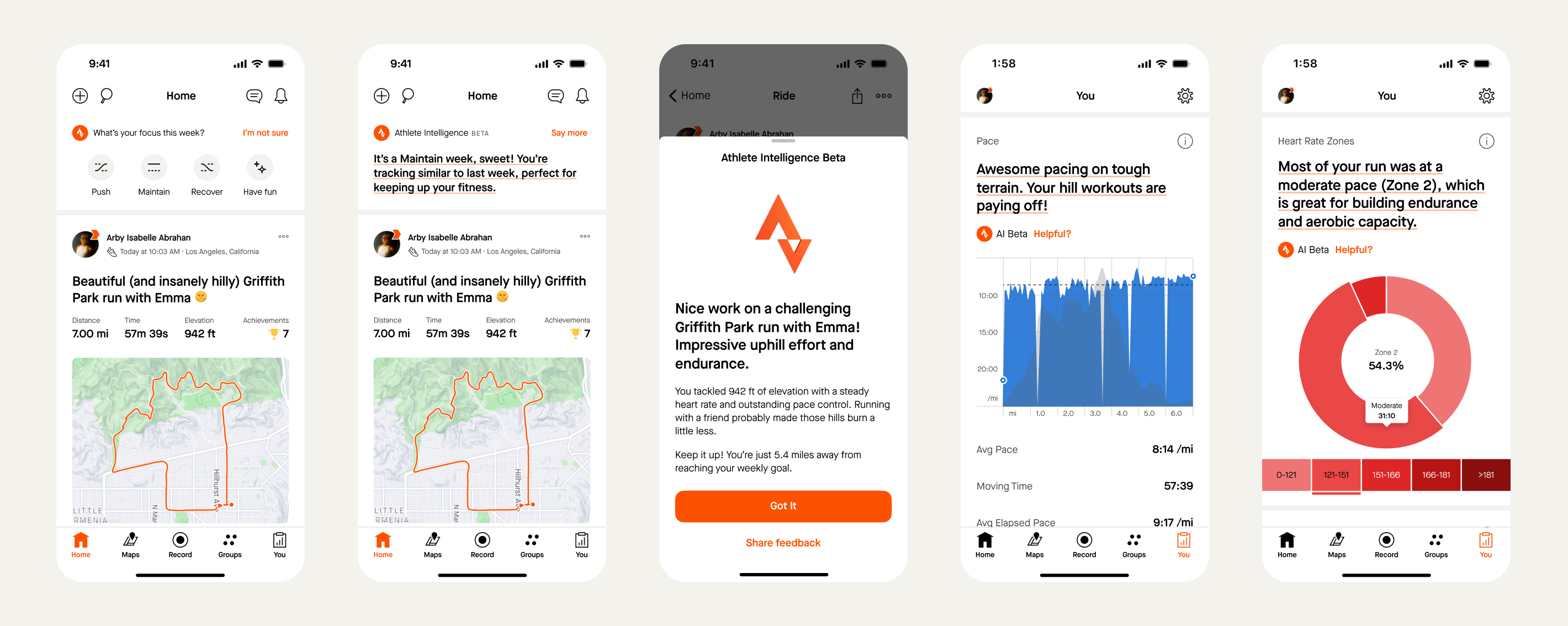Strava CEO on where the fitness app is going – and why bizarre leaderboard cheats have an upside
Activity-based platform is rare among popular apps in that it actually wants you to be doing something else, says its relatively new boss Michael Martin
Michael Martin sits high above Nice’s Promenade des Anglais. From his view from a hotel terrace, he can see down as people on bikes sprint and whip their way around one of the world’s most famous roads, beneath some of the world’s most famous cycling hills.
A couple of hours later, the world’s fastest cyclists will race into Nice to end the Tour de France. A couple of weeks later, most of those same cyclists – and many more besides – will be back in France for the Olympics. Then some of them will stay on for the Tour de France Femmes.
But Martin sits at the head of an organisation in control of leaderboards more busy than the Tours’ grand classifications, and records more challenged than those in the Olympics. He is engaged in a mission to keep those competitions as fun and fair as possible, one that requires constant vigilance and reinvention.
Because Martin is the still relatively new chief executive of Strava, the fitness app that is something between a training platform, a social network, and the world’s biggest race. It holds a vast database of 120 million athletes’ exercises; not just what they’ve done, but where and how quickly.
The big problem that Martin wanted to solve first, however, was also seemingly those users’ biggest concern: dark mode. Apple introduced the feature in 2019, and allowed other apps to adopt it – most did, but that meant that those outliers that didn’t were especially notable, since they shone a bright white light into a users’ eyes that had got used to dark screens.
Perhaps the biggest holdout was Strava. The company tried, and was delayed, and gave explanations including the fact that a dark mode required every single part of the app to be flipped and checked to ensure that it looked good in both colours.
Soon after Martin joined, he made a video in which he read users’ mean tweets about the company’s delay in instituting it. (“That was not my idea,” he says, “it was a brilliant idea”.) And he announced, at last, that the company would finally be making it available, which it now is.
For years, Strava had struggled with dark mode because every calculation of how much work it would take suggested that it would never actually happen. Martin instituted what Google calls a “code yellow”: a problem so glaring that it needs to become the priority of everyone in the company. Every available engineer, UX designer and anyone else who might be useful was pulled onto the project, working through it every day, and finally Strava went dark.
The problem was partly because Strava is so established: its website and its app, which function separately, have both accrued complications and context that wouldn’t be there if they were being launched now. Much of that has now been paid off and will allow engineers to more quickly bring new updates: dark mode should be followed by other introductions, he said, though it’s not clear whether any of them will prompt quite such an overflow of emotions, or mean tweets.

The whole thing showed two things central to Strava, and Martin’s now six months at the head of it. The first is that it has been slow moving, with an old website and a sometimes neglected app that led some users to complain that their relatively hefty subscription fees should be being exchanged for new features. But the other is just how engaged those users are: they didn’t leave the site, they just complained about it publicly and vocally, but largely because they wanted it to be better.
“The community is Strava at the end of the day,” he says, as some of its members continue to cycle through the hot Riviera morning beneath us. “I love the fact that the community is so passionate – not just about what they’re doing, but about Strava and what it’s doing to help them in their goal.”
Part of that is because the app is aimed at helping people do something that they love and is good for them. Martin moved to Strava from Google, but before that he worked at Nike, where he says he learned that “there is a unique emotional component to motivation and fitness and activity”. He points at some of those sunbaked runners below: “if their product fails them on that run, they get mad; this is the peak emotional moment”.
Its commitment to activity – as well as its relatively unusual approach to monetisation, which comes through a premium subscription model – means also that Strava is focused on ensuring that people enjoy their time on the app and leave, rather than the endless engagement of social media platforms. Users might love Strava, but they love it in part because it is a way to go and do something else.
On other platforms, “every product decision that the team is making is intended to optimise how long you engage in that app – scrolling through the feed, swiping from video to video. At the end of the day what I love about Strava is the purity of its mission: the goal of Strava is to get you to go and do something in the outside world, it’s not to engage with the app itself”.
There will be more social features to come, he says without naming them, as part of a broad push under Martin’s leadership to actually build and ship more meaningful new features and updates to customers. “But we’re going to take a close look on making sure that every feature, and every component of that feature, including all the way to how we roll it out, is finely tuned to motivate people to go do something else, not just to have them post stuff and engage”. Strava says that for every minute people spend in its app they do 20 minutes of activity, and that remains on its key metrics, he says; while the company does pay attention to whether people are engaging with their community and their friends, the really important thing is whether people are still going out and doing things.
Many of the new features – those that aren’t dark mode, at least – that have been introduced by Martin so far were infused with artificial intelligence. But they were nonetheless features; at a time when every technology company wanted largely to be seen to use the words, Strava said that it would integrate AI but only in practical terms. So earlier this year it introduced a tool called “Athlete Intelligence”, for instance, which will chew up people’s data and give them easily digestible summaries about the sort of exercise they have done and should be doing.

Which is perhaps where Strava’s most controversial feature comes up: those segments and those leaderboards. They allow any road or path to be cut into small pieces and then raced, with results tracked and uploaded through GPS trackers.
The idea for them came about in 2003 from one of Strava’s founders, and they are a central part of the app. Some of them have taken on such iconic status that people train for months to rise up those leaderboards. There are now tens of millions of segments in the app.
There is also a significant number of cheaters. Some do it by accident, as when they might leave their tracking on after they get back into the car; others do it intentionally, though it is never clear exactly why. Some are obvious, as when people people break the world record; some are more unclear. What is definitively true is that those users – many of them very passionate – are very angry about them.
“The leaderboards and the integrity of the leaderboards is such a sacrosanct aspect of Strava,” he says. “And I get that Strava is effectively like the system of record for achievement in the world. And that achievement comes back to the passion: your heart and your soul and your sweat and your pain and all the rest of it.
“And if somebody else stole that achievement because they were cheating, that’s terrible, and it undercuts the whole purpose of the product as a whole.”
Martin heard two key things about the leaderboards as he started his new role: they need cleaning up, but also that it should be easy to clean up. Could you not just check if they are moving faster than a human possibly can, for instance? But that’s a “bad tool to solve that problem”, he says, and previous attempts to do so didn’t work.
Instead, Strava is learning into machine learning, which he says “is a perfect tool to solve that problem, or as perfect as we’ve created at this point”. Built to digest data and spot outliers, AI could be perfect to see people who are claiming to have gone faster than they really have.
It’s still not clear why people are trying to play this system in the first place. You don’t get anything – apart from encouragement from your friends – when you top even a competitive leaderboard. There are no prizes and nobody even knows you have the spot unless they make a point to look. But Martin offers a mysterious story, one that traverses the world and takes in the economies of countries, that he says might offer some insight.
“There’s something happening right now, you may have heard about it. It’s starting to make it into the western press. But one of our fastest growing markets is Indonesia.
“And Indonesia, like a lot of countries in Asia, are reaching this point of development where middle class populations are not only occurring but growing to great size. They have enough wealth and time that they’re focused on their fitness and health and things like that.
“And in Indonesia, there’s this phenomenon: it’s basically called a jockey, and they use the Indonesian term for jockey. And what's going on is people are going to the leaderboards. They're seeing people who are at the top of the leaderboard. They're reaching out to them and offering them money to come and record using their profile so they can go to the top of the leaderboard.”
Strava wants to stop them, and is doing so in both its product but also its marketing and messaging, to ensure that the leaderboards’ integrity stays intact. “But what that also demonstrates is an innate desire to really kind of reach the tail end of it – they want to see themselves as that faster, better, healthier version of themselves.
“They're not taking the right approach to do so,” he says with a laugh. “But the motivation to do so, the aspiration, the admiration that underlies that – that’s a powerful thing and a positive thing.”
Strava has long been focused on inclusivity, and Martin is very clear that he wants to keep that mission going. But the fiery fight for the top of the leaderboard also shows just how competitive Strava can sometimes be – a reputation that, at least in its early years, meant that it acquired a reputation for being something of a home for middle-aged men in lycra, obnoxiously rushing around to win a kind of virtual grand tour around their homes.
Strava says that it is working on a host of ways to make both the app and the activities that it enables to be more open to more people. Many women are kept from being active because of safety concerns, for instance, and so Strava is rolling out initiatives including night heat maps that allow runners to see which parts of local area are likely to be more busy late at night.

He points also to a focus on menstrual health, acknowledging that it is “key component of activity for many women” and suggests that not enough fitness products are understanding or treating that properly. “That’s a key area for focus for us,” he says, though he declines to give any details on new features that might bring it into Strava.
The company is also working to ensure that the app does not feel exclusively about going hard or fast. As we sit waiting the arrival of the final stage of the Tour de France, we look back on three weeks in which some of the fastest riders in the world have used Strava to share data and rides that are impossibly quick – and the app lets you know just how impossibly quick they are, by comparing their output with your own. To some that might be inspiring, but to others it might be quickly demotivating.
Martin notes that Strava initially found its users among those who did indeed find that helpful. But he wants it to be inspiring to everyone, too. He points to a conversation with accomplished runner Lauren Fleshman, who noted that she runs with both friends who are still professionals and also a group of fellow mothers who get out for runs to keep active. “And the way I think about Strava is that we need to support both – because even if somebody is at the absolute pinnacle of human fitness and achievement, that’s a moment in time that’s not something that they’re going to hit and then stay at for the rest of their days.”

Many of those people might have joined during covid, when activity became a key way of keeping up movement and contact with the world. Strava was one of a number of health and fitness companies that saw incredibly growth during the pandemic – but others, such as Peloton, have fallen off dramatically in the time since. It doesn’t have that problem, he says: it “certainly saw a lot of growth in new users at that point, but it was able to build upon that and now accelerate again”. In some ways it is growing faster than during the pandemic, he says, and it is still speeding up.
Gen Z, despite their associations with TikTok, accounts for a third of the platform and is the fastest growing population. Despite everything that his said about them, that generation is looking for community, for connection – he says that “really Strava isn’t about the product”, but the people on it, and it is them that are helping it to grow.
A few hours later, the fastest Gen Z on the planet, 25-year-old Slovenian cyclist Tadej Pogačar, powers into Nice to win both the stage and the overall victory in 2024’s Tour de France.
“Final stage [time trial] W,” he posts to Strava in typical understated style, getting the win seemingly now so assured and regular that he doesn’t need to use its second or third letters. As he arrives and the Tour ends, with the roads opening back up and the decorations coming back down, a host of cyclists take to the streets to try and get home; they’ve got training to do, since Pogačar didn’t just win the race, he also took the top crown on a whole array of segments as he made his way into the city.
Join our commenting forum
Join thought-provoking conversations, follow other Independent readers and see their replies
Comments
Bookmark popover
Removed from bookmarks